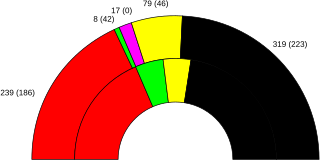1990 German federal election
| ||||||||||||||||||||||||||||||||||||||||||||||||||||||||||||||||||||||||||||||||||||||||||||||||
All 662 seats in the Bundestag 332 seats needed for a majority | ||||||||||||||||||||||||||||||||||||||||||||||||||||||||||||||||||||||||||||||||||||||||||||||||
|---|---|---|---|---|---|---|---|---|---|---|---|---|---|---|---|---|---|---|---|---|---|---|---|---|---|---|---|---|---|---|---|---|---|---|---|---|---|---|---|---|---|---|---|---|---|---|---|---|---|---|---|---|---|---|---|---|---|---|---|---|---|---|---|---|---|---|---|---|---|---|---|---|---|---|---|---|---|---|---|---|---|---|---|---|---|---|---|---|---|---|---|---|---|---|---|---|
| Registered | 60,436,560 | |||||||||||||||||||||||||||||||||||||||||||||||||||||||||||||||||||||||||||||||||||||||||||||||
| Turnout | 46,995,915 (77.8%)[1] | |||||||||||||||||||||||||||||||||||||||||||||||||||||||||||||||||||||||||||||||||||||||||||||||
| ||||||||||||||||||||||||||||||||||||||||||||||||||||||||||||||||||||||||||||||||||||||||||||||||
 Results by state for the second votes. Light blue denotes states where the CDU/CSU won a plurality of votes; darker blue denotes states where CDU/CSU won an absolute majority of votes; pink denotes states where the SPD won a plurality of votes; red denotes where the SPD won an absolute majority of votes. | ||||||||||||||||||||||||||||||||||||||||||||||||||||||||||||||||||||||||||||||||||||||||||||||||
| ||||||||||||||||||||||||||||||||||||||||||||||||||||||||||||||||||||||||||||||||||||||||||||||||
Federal elections were held in Germany on 2 December 1990 to elect the members of the 12th Bundestag. This was the first all-German election since the Nazi show election in April 1938, the first multi-party all-German election since that of March 1933, which was held after the Nazi seizure of power and was subject to widespread suppression, and the first free and fair all-German election since November 1932. The result was a comprehensive victory for the governing coalition of the Christian Democratic Union/Christian Social Union and the Free Democratic Party, which was reelected to a third term.
Issues and campaign
This was the first election conducted after German reunification which took place on 3 October. Almost 150 seats had been added to represent the newly re-established eastern states of Germany without reducing the number of Western members. The euphoria following the reunification gave the ruling CDU/CSU–FDP coalition a dramatic advantage in both Western and Eastern Germany throughout the campaign.
This was the one and only election for which the 5% threshold was not applied nationwide, but separately for East Germany (including East Berlin) and West Germany (including West Berlin). As a result, while the Western The Greens failed to gain representation, an ideologically similar party from the East, Alliance 90, did. They merged to form Alliance 90/The Greens in 1993.
Results
| This article is part of a series on the |
| Politics of Germany |
|---|
 |
All change figures are relative to the pre-existing West German Bundestag.
Template:German federal election, 1990
| 319 | 79 | 239 | 17 | 8 |
| CDU/CSU | FDP | SPD | PDS |
Results by state
| State | Union | SPD | FDP | Grüne | PDS | Others |
|---|---|---|---|---|---|---|
| style="background:Template:CDU/CSU/meta/color;"| | style="background:Template:Social Democratic Party of Germany/meta/color;"| | style="background:Template:Free Democratic Party (Germany)/meta/color;"| | style="background:Template:Alliance 90/The Greens/meta/color;"| | style="background:Template:The Left (Germany)/meta/color;"| | ||
| 46.5 | 29.1 | 12.3 | 5.7 | 0.3 | 6.1 | |
| 51.9 | 26.7 | 8.7 | 4.6 | 0.2 | 7.9 | |
| 39.4 | 30.6 | 9.1 | 7.2[c] | 9.7 | 4.0 | |
| 36.3 | 32.9 | 9.7 | 6.6 | 11.0 | 3.5 | |
| 30.9 | 42.5 | 12.8 | 8.3 | 1.1 | 4.4 | |
| 36.6 | 41.0 | 12.0 | 5.8 | 1.1 | 3.5 | |
| 41.3 | 38.0 | 10.9 | 5.6 | 0.4 | 3.8 | |
| 44.3 | 38.4 | 10.3 | 4.5 | 0.3 | 2.2 | |
| 41.2 | 26.5 | 9.1 | 5.9 | 14.2 | 3.1 | |
| 40.5 | 41.1 | 11.0 | 4.3 | 0.3 | 2.8 | |
| 45.6 | 36.1 | 10.4 | 4.0 | 0.2 | 3.7 | |
| 38.1 | 51.2 | 6.0 | 2.3 | 0.2 | 2.2 | |
| 49.5 | 18.2 | 12.4 | 5.9 | 9.0 | 5.0 | |
| 38.6 | 24.7 | 19.7 | 5.3 | 9.4 | 2.3 | |
| 43.5 | 38.5 | 11.4 | 4.0 | 0.3 | 2.3 | |
| 45.2 | 21.9 | 14.6 | 6.1 | 8.3 | 3.9 | |
| Old states (West) | 44.3 | 35.7 | 10.6 | 4.8 | 0.3 | 4.3 |
| New states (East) | 41.8 | 24.3 | 12.9 | 6.2 | 11.1 | 3.7 |
Post-election
The governing CDU/CSU-FDP coalition was returned to office with a landslide majority, and Helmut Kohl remained chancellor. The CDU did exceptionally well in the former East Germany, which had been the heartland of the SPD before the Nazi era.


Notes
- ^ Schröder was endorsed as the SPD's Chancellor candidate on 20 March 1990, but was not party leader.
- ^ Lafontaine was elected in Saarbrücken, but did not accept his mandate after the election.
- ^ 3.9% West German Green Party, 3.3% East German Green Party/Alliance 90.
References
- ^ "Voter turnout by election year". Website of the Federal Returning Officer's Office. The Federal Returning Officer. Archived from the original on 7 November 2014. Retrieved 7 November 2014.





